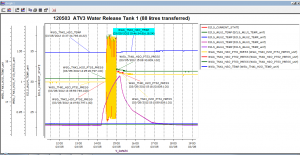CONTINUED — Diary from a space project 3 May, Thursday, L+42
A continuation of Charlotte Beskow’s ‘Mission Diary’ update from last week. PLUS: Read below for a great overview of the orbital debris situation – Ed.
Water transfer
Independently of what were were doing on the RICU, the crew took the opportunity last week to discharge some more water. Twenty two litres of Russian water was transferred to a Russian water container; a total of 88 litres have now been transferred.
Apart from the verbal reporting on the voice loops, we can monitor these transfers by looking at the pressure parameters of the ATV tanks. Another good indication that something is happening inside ATV is the ON / OFF status of the lights inside ATV.
As an aside, we note that each crew is different: some always turn the lights OFF when they leave, others leave at least one light ON all the time — just like the rest of us!
As we left work on Thursday evening [3 May], ATV was back on the redundant interface to the ISS (RECS chain 2).
Reboost and Debris Avoidance Manoeuvres
On Friday morning, 4 May, ATV was set into the mode required for attitude control and reboost. (This involves setting the propulsion system in to the proper mode with activation of the control chains that are to be used). This type of operation also involves obtaining power from the ISS. The reason, of course, is that the attitude of ISS is defined by its needs, not by what is favourable to the illumination of the ATV solar arrays.
Once ATV is in the correct mode (ISS_AC or ISS_REB, for those of you interested), the Russian computers can communicate directly with the ATV thrusters. The actual thrust impulses to be executed by each thruster (ATV has 4 main thrusters plus 28 smaller thrusters) are calculated by Russian mission control experts and uplinked to the ISS.
At ATV-CC, our ATV experts monitor the set up of ATV and then the ESA Engineering Support Team propulsion experts check the behaviour of the systems during the boost (thermal aspects, firings, fuel consumption, etc,).
The Friday reboost (the third time we activated our main thrusters since we docked to the ISS) was successful. Via this manoeuver, ATV added 3 m/second to the speed of the ISS.
After every reboost, the consumed propellant is calculated and we update the estimates of what remains on board. We know how much ATV needs to be able to perform a nominal departure and reentry and then e add some margin so that we can handle contingencies, and the remaining amount is what can be used for ISS reboosts.
The status after Friday’s successful reboost is roughly as follows:
- Loaded fuel: 5,410 kg
- Amount used to get to ISS: 650 kg
- OCS boost 31 March (1 m/s – ‘test’ reboost): 140 kg
- OCS boost 5 April (ca 2.3 m/s): 300 kg
- OCS boost 4 May (ca 3 m/s): 390 kg
ATV also needs a certain amount of fuel in order to leave ISS and reenter the Earth’s atmosphere in a safe and controlled manner. Therefore the remaining amount that can be used for ISS is in the order of 2,700 kg.
This propellant will be used during the remainder of our stay at the ISS. Most of the use will be preplanned but, as always, ISS needs margins to cope with unplanned situations, for example potential orbital debris conjunctions (these can happen with little/no notice).
In this case, the ISS must be ready to perform a debris avoidance manoeuvre (DAM for short). So, what do we mean by this term?
The ISS provides a pressurised environment in which the crew members can live and work almost as if they were on ground (‘almost’ since the ISS is in a permanent state of free-fall, providing the microgravity conditions required for orbital science experiments).
If the ISS were to collide with any of the multitude of debris objects orbiting Earth, the consequences could be catastrophic.
For this reason, NASA continuously tracks thousands of objects and if one of them risks intersecting the orbital path of the ISS then a manoeuvre is planned on short notice. While attached to the ISS, ATV performs this function. Normally, we have at least 24 hours notice.
Very often, during the previous ATV stays at the ISS, such objects would be identified. A preliminary warning would be issued to allow the teams to prepare, the evolution would be tracked and then either the manoeuvre was executed or (most often) cancelled.
Debris alerts happen fairly frequently. As an example it is worth mentioning that Crew had to go into their Soyuz capsules (for quick return in case of a debris hit) on Saturday, 24 March, just shortly after ATV was launched!
Apart from the successful reboost on 4 May, the EST the teams spent Friday and Saturday on data analysis. Not the favourite plan for a weekend, but the company was great and the weather not very co-operative.
By the time I headed to the airport on Monday, 7 May, the Sun was again shining and it felt very much like summer… not quite like vacation though.
That’s it for now… stay tuned!
— Charlotte
Editor’s notes:
Orbital Debris Quarterly News: “For the first dozen
years of its existence, the ISS averaged only one
collision avoidance manoeuvre per year. However, in
the past 12 months (April 2011 to April 2012), the
ISS was forced to execute four collision avoidance
manoeuvres and would have conducted two additional
manoeuvres if the warnings had come sooner.”
MORE INFORMATION


 Automated Transfer Vehicle page
Automated Transfer Vehicle page ATV blog archive
ATV blog archive
Discussion: no comments